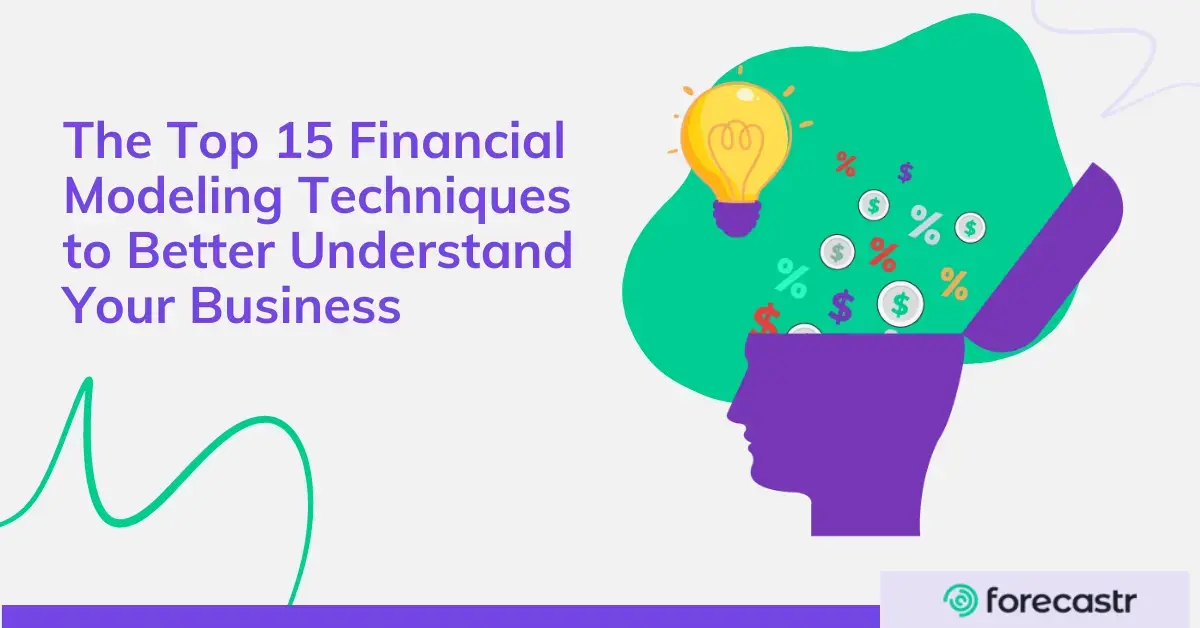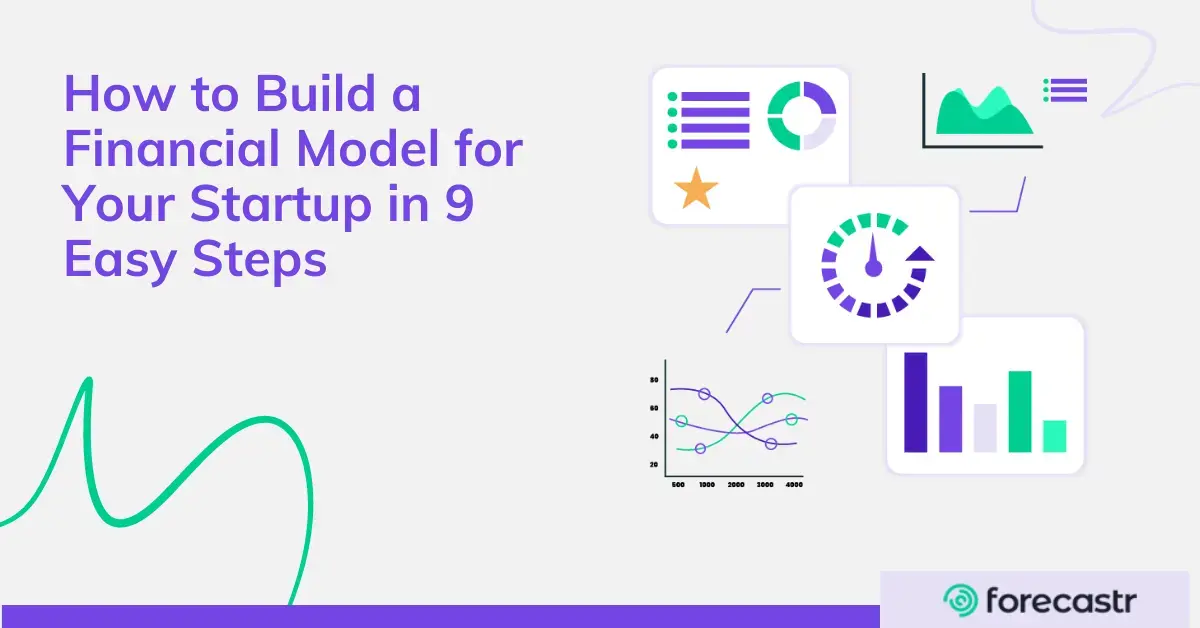Top 15 financial modeling techniques for business clarity
Imagine navigating your way through a dense forest without a map. That's business without financial modeling. It's essential, yet daunting for many....
Diving into financial modeling prep is like unlocking a secret code that can predict the future of businesses and investments. It's essential, yet daunting for many. This journey we're about to embark on will simplify it, breaking down complex concepts into bite-sized, manageable pieces.
You'll learn how Excel remains an unbeatable tool in financial modeling but also why venturing beyond it with Forecastr's service offerings could elevate your analysis game. From mastering cash flows in DCF models to navigating through M&A and LBO intricacies, you're set to gain insights that are pivotal for any aspiring financial wizard.
By the end of this read, not only will budgeting and forecasting seem less intimidating; but you'll be equipped with validation techniques ensuring your models stand up against real-world scrutiny. So let's start demystifying financial modeling together.

Table of contents
Imagine financial modeling as the GPS for businesses navigating through the complex world of finance. It's not just about crunching numbers; it’s about crafting a story that tells where a business is headed financially, based on solid data and assumptions.
In its essence, financial modeling involves creating abstract representations (a model) of a real-world financial situation. This could be anything from forecasting future income statements and balance sheets to making crucial investment decisions or pricing securities. Given its pivotal role in corporate transactions, understanding how to prep and build these models becomes indispensable.
Financial modeling's allure stems from its adaptability, finding utility in realms as varied as finance, medicine, and tech—essentially wherever numbers meet strategy. Its importance cannot be overstated when we consider that over ten different types of models are employed depending on the specific analytical need at hand such as DCF (Discounted Cash Flow), M&A (Mergers & Acquisitions), or LBO (Leveraged Buyout).
To dive deeper into examples and applications of various financial models, this resource can serve as an excellent starting point.
The three-statement model is the foundation of most financial models. It integrates the income statement, balance sheet, and cash flow statement into a single, cohesive model. By linking these three key financial statements, this model provides a comprehensive overview of a company's financial health, performance, and future prospects. This integration ensures consistency across all financial data, allowing for accurate projections and analysis.
The DCF model, short for Discounted Cash Flow, is the superhero of financial models. Delving into the essence of a business, this approach forecasts its forthcoming cash injections and recalibrates them to their current worth. Imagine you're trying to figure out how much a golden goose might be worth based on the eggs it'll lay in the future; that's your DCF at work.
This method shines brightest when assessing long-term investments because it considers the time value of money—a dollar today isn't worth the same as a dollar tomorrow. With over ten different types highlighted for various purposes, understanding each one becomes crucial.
If diving into numbers excites you as much as jumping into a pool on a hot day, check out this guide on financial modeling examples. It's like having GPS directions in an unfamiliar city—essential.
Mergers and Acquisitions (M&A) models are like matchmakers of the corporate world—they help determine whether two companies would make a good pair financially speaking. This type digs deep into how an acquisition could affect earnings or reveal potential synergies between entities. If considering what peanut butter is to jelly can do for sandwiches gets you going, M&A modeling will be right up your alley.
The trick with M&A models lies not just in crunching numbers but also understanding market trends and regulatory impacts—which makes them both challenging and intriguing puzzles to solve.
Last but certainly not least is our friend—the LBO model or Leveraged Buyout model. Think about buying something using mostly borrowed funds; that’s essentially what an LBO does with businesses. The strategy zeroes in on snapping up companies by leveraging hefty loans, all the while ensuring that cash injection remains at a bare minimum.
Leveraging this tactic, the goal is usually to enhance or reconfigure the inner workings of companies for improved financial performance, ultimately preparing them for a profitable sale or to reintroduce them into the public market. It requires meticulous planning around debt repayment schedules and operational improvements, making it a critical tool private equity folks swear by whenever they're eyeing new acquisitions.
Getting hands dirty figuring out how to turn around a company using clever financing tactics? Then mastering LBO should be on your bucket list.
The CCA model, also known as "comps," involves comparing a company's financial metrics with those of similar companies. This model uses valuation multiples such as price-to-earnings (P/E), enterprise value-to-EBITDA (EV/EBITDA), and price-to-book (P/B) ratios to assess a company's relative value. CCA models are widely used in investment banking and equity research to determine a company's market value based on its peers.
An IPO model is used to evaluate the potential value of a company planning to go public. This model includes detailed projections of the company's financial performance, valuation multiples, and potential offering price. IPO models help companies and underwriters determine the appropriate pricing and timing for an initial public offering, ensuring that the company is valued fairly and attracts investors.
A budget model is used for internal planning and forecasting. This model projects a company's financial performance over a specific period, usually a fiscal year. It includes detailed estimates of revenues, expenses, capital expenditures, and cash flows. Budget models help management set financial targets, allocate resources, and monitor performance against budgeted figures.
Forecasting models project a company's future financial performance based on historical data and assumptions about future trends. These models can be short-term or long-term and are used for various purposes, including strategic planning, resource allocation, and performance evaluation. Forecasting models help companies anticipate future challenges and opportunities, enabling proactive decision-making.
Diving into the world of finance unveils a plethora of strategies and instruments, illuminating the critical importance for aspiring magnates and seasoned CFOs alike to master these essential methodologies for astute investment choices and proficient fiscal management. Whether a beginner or seasoned professional, expanding your knowledge base and exploring complexities beyond traditional methods can open doors to opportunities previously unseen.
No tool is more synonymous with financial modeling than Excel. Even after all these years, its unparalleled ability to craft intricate forecasts and scrutinize data, thanks to its adaptability and easy access, keeps it at the pinnacle of financial modeling tools. However, knowing your way around VBA can take your Excel game from good to great allowing for automation which saves time during those long nights tweaking formulas.
Beyond traditional tools like Excel exists specialized services designed specifically for heavy-duty number-crunching.
Forecastr's Features stand out among these, offering comprehensive solutions tailored towards modern-day needs. But don’t let their sophistication scare you.
With basic financial knowledge, anyone can learn how to leverage these advanced platforms, enhancing accuracy and efficiency along their journey toward becoming a pro modeler.
In investment banking circles, where time equals money more directly than anywhere else, efficiency isn't just nice—it's necessary.
Financial models serve as critical decision-making tools whether evaluating mergers & acquisitions or forecasting quarterly revenues; thus making these skills invaluable.
The demand remains sky-high within this sector due not only to competitive salaries but also because bankers rely heavily on accurate projections crafted through sophisticated modeling techniques—a blend of science and intuition refined over countless hours behind screens filled with numbers.
Note: While diving deep into finance’s technical side might seem daunting at first glance—especially if coming from another field—the rewards justify the effort manifold times over.
By dedicating time and effort to master these crucial tools and skills, you'll not only gain more confidence in managing financial landscapes but also develop keener insights into identifying opportunities where numbers intersect. Adopting this strategy is key for those aiming to flourish amidst the intricacies of the financial realm.
In the fast-paced world of business, getting your budgeting and forecasting right is like having a crystal ball. But let's face it, magic doesn't get the job done; financial models do. Far from being mere calculators, these instruments serve as the cornerstone for devising strategies in diverse sectors including property development, digital innovation, and industrial production.
Imagine trying to predict how much cash you'll need next quarter without a detailed financial model. Attempting to navigate the future without these analytical tools is akin to wandering in obscurity. In this scenario, models serve as the guiding light for enterprises, enabling them to project forthcoming outcomes with astonishing precision.
This accuracy stems not from mere speculation but from a meticulous examination of historical data, market dynamics, and possible outcomes to craft educated forecasts on forthcoming income or costs.
Financial modeling plays a pivotal role in assessing company values, serving as the foundation for investment choices across all tiers. Whether it’s venture capitalists mulling over startups or pension funds weighing their stakes in blue chips, understanding a company's value is paramount.
Determining a company's worth frequently rests on complex financial frameworks that consider various elements, including anticipated profit expansion and sector-related hazards. Such analyses help investors set price targets for stocks by estimating what those shares will truly be worth down the line—not just based on current share price movements but grounded in solid fundamentals analysis.
The intricate dance between risk assessment and opportunity spotting makes valuation an art as much as a science—yet one more reason why mastering financial modeling is indispensable for anyone serious about making savvy investment decisions or advising others who do so.
You might think diving into this could turn up more questions than answers because let’s admit it: finance can get complicated. Yet through hands-on experience backed by rigorous practice (and maybe some caffeine), turning complex data sets into actionable insights becomes second nature—highlighted perfectly when considering major transactions such as mergers & acquisitions (M&A) or leveraged buyouts (LBO).
A real-life application: Think Berkshire Hathaway.
We've all heard stories about Warren Buffett making blockbuster investments after porridge for breakfast—but behind every headline-grabbing move are reams of painstakingly prepared financial models.
Berkshire Hathaway uses these analytical frameworks not only to pinpoint undervalued assets but also to steer clear of seemingly lucrative opportunities marred by hidden risks.
Building a financial model feels like constructing a bridge. You want it strong enough to hold up under pressure, but flexible enough to adapt when conditions change. To ensure your financial models can withstand the test of time and uncertainty, employing robust validation techniques is non-negotiable.
Kicking things off, it's paramount to highlight that pitting your financial models against the annals of history through back-testing emerges as an indispensable phase in their verification process. This method entails juxtaposing the forecasts of the model against real historical events to gauge its accuracy. It’s like running a time-travel experiment on your model to see how well it would have performed had it been used in previous years.
If you're wondering about its importance, consider this: without back-testing, you’re essentially driving blindfolded hoping that the road doesn’t turn. By revisiting past performance through back-testing, we uncover and refine any imperfections in our hypotheses, thereby sharpening the precision of future predictions.
Moving on, sensitivity analysis shines light on how changes in key inputs affect your model's outputs. Think of it as testing how sensitive your model is if market conditions were to do a 180 overnight or if certain variables zigzagged unexpectedly.
This method digs into questions like "What happens if interest rates soar?" or "How does our profit forecast shift with a 10% increase in raw material costs?". By pushing these boundaries through sensitivity analysis, decision-makers gain insights into potential vulnerabilities within their models and can plan accordingly.
Beyond automated tests and simulations lies an equally powerful tool: peer review. Having another set of eyes—or several—go over your work isn't just about catching mistakes; it's an opportunity for constructive criticism that could significantly refine your modeling approach.
Involving colleagues from different departments or external experts adds diverse perspectives which might uncover oversights one person alone couldn't spot. These sessions evolve from mere critique gatherings into joint ventures, sharpening our ability to predict financial trends with greater accuracy.
Last but certainly not least, embracing continuous learning and updating plays an indispensable role. In a world where market dynamics shift, regulatory landscapes transform, and business tactics take new directions, our economic frameworks need to adapt accordingly. This means regularly revisiting assumptions, integrating new data sources, and refining methodologies based on the latest trends and surrounding economic conditions. Remember: A static model is a dormant one; keeping it dynamic ensures it remains relevant and reflective of real-world complexities.
So, we dove deep into financial modeling prep. It's clear now: mastering Excel is crucial but exploring Tidemark opens new doors. Remember, beyond the spreadsheets and software lies the real magic of making informed decisions.
Different models serve different needs - from DCF to LBOs. Knowing which one fits your scenario can change the game.
Validation techniques like back-testing aren't just steps; they're safeguards for your analysis.
Financial modeling transcends mere number crunching; it's the art of forecasting the future with accuracy and assurance. Equipped with this knowledge, you're well-prepared to navigate the challenges that lie ahead in this intricate domain.
Schedule a demo with Forecastr today.
Get notified about new events, free resources, and fresh content

Imagine navigating your way through a dense forest without a map. That's business without financial modeling. It's essential, yet daunting for many....

For savvy investors in today's game, real estate financial modeling is the ticket to making informed, smart decisions in property investment. It...

Stepping into the startup world feels like diving headfirst into a sea of uncertainties. But, crafting a solid startup financial model is your...